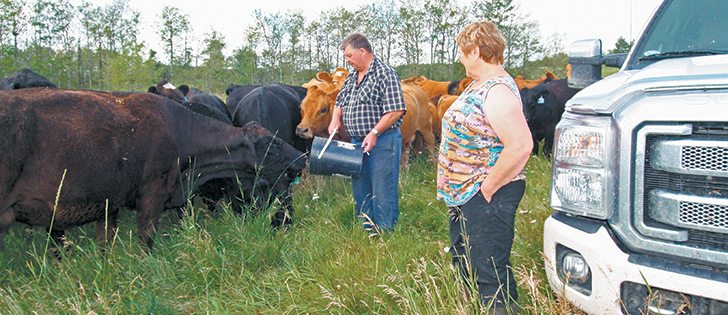INGLIS, Man. — Glenda and Barry Chescu credit their purebred Simmentals with keeping their farm in business for four decades.
“It gave us that little bit of extra to keep us going,” said Glenda.
The couple has a 230 head herd and seeds 700 acres to barley, oats and canola, some of which becomes silage for the cattle.
Their Twin Brae Simmentals are named for the post office that once operated near their farm. Barry’s grandfather emigrated from Romania and settled on neighbouring farmland, and his brothers continue to farm in the region.
Read Also

India slaps 30 per cent import duty on yellow peas
India has imposed a 30 per cent duty on yellow pea imports with a bill of lading date on or after Nov. 1, 2025.
The farm is not likely to be passed to their adult children, Joey and Kerrie, who have careers in nearby cities, so the Chescus plan to sell 180 head this November. That’s in addition to 125 bred females sold five years ago.
“We know neither child is taking over the farm so how long do you wait to sell?” said Glenda.
Added Barry: “It’s come to a time in our lives that we can’t manage it anymore.”
“When things are all on your shoulders, things get left undone,” he said, noting they could use a half or three-quarter time labourer if they could find one.
The Chescus market their herd at a bull sale and at a production sale, where they sell bred heifers. They minimized the effects of BSE by butchering and selling from their farm and with Glenda’s off farm work at a veterinary clinic.
Despite the challenges, Barry said the cattle business allowed them a chance to meet people.
They are members of the Canadian Simmental Association, and Glenda once served on the provincial breed association board. They also used to show their animals at events such as Western Canadian Agribition and Brandon’s Ag Days and Winter Fair.
Glenda said her own family had Charolais while she was growing up, but she likes Simmentals. The Chescu family used to milk them and sell the cream in addition to raising 1,500 chickens.
“The kids did a lot of the work here,” Barry said. “It was something that was expected of them, and they never backed away from it.”
He called Simmentals a docile breed, noting how they never worried about the cattle around their family.
“The bulls were big pets,” he said. “They had more things as a breed. They offered us what we were looking for.”
Added Glenda: “We were looking for a breed that would make money.”
The children showed them for 4-H projects, and their parents served as leaders for two decades. Barry also judged cattle breed shows, which allowed him to learn about other breeds.
Glenda handled their herd’s paperwork and helped where needed. All farm decisions were made as a couple.
“We are partners and we work together,” said Barry.
They supplement their income with an auction business that includes Joey, but business has waned in recent years from the days of 25 auctions a year. Glenda is also a distributor for East Man Feeds.
Barry, a longtime rural municipality councillor and now reeve in the RM of Riding Mountain West, said that role also keeps him busy. There have been adjustment pains from recent RM amalgamations and flooding concerns from an abundance of beavers damming waterways.
On the positive side, the RM benefits from cottagers and a ski hill that bring people to the area to live and work.
“It’s a win-win for everybody,” said Barry.
This year has been wetter than they would like, and they plan to hire someone to do the haying for them because the crop is so wet and lush.
They will also keep fall calves to manage the grass.
“We’d like to see a month of sunshine and 25 C temperatures,” Barry said. “We have enough moisture to carry us to fall.”















